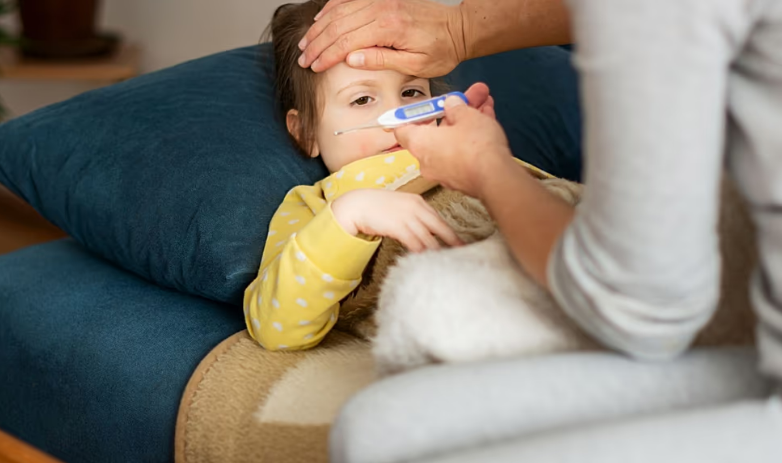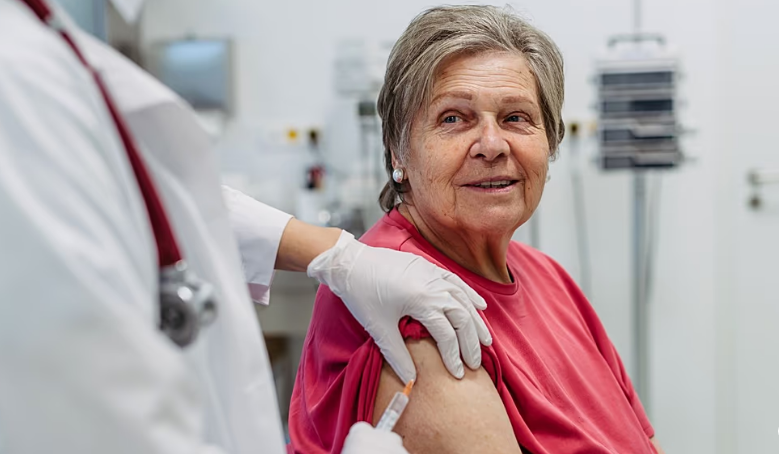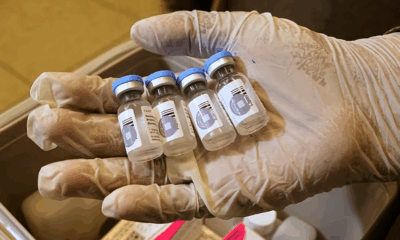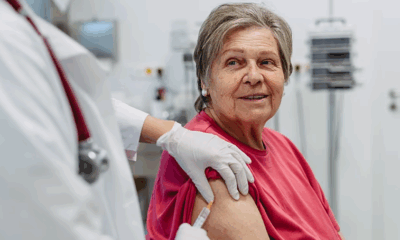Health
Europe Braces for Early and Potentially Severe Flu Season as Health Officials Urge Immediate Vaccination

Health authorities across Europe are warning of a potentially tough winter as influenza begins spreading weeks earlier than usual, driven by a new viral strain that is circulating rapidly across the region. Officials are urging people most at risk to get vaccinated “without delay” to avoid a surge in infections and pressure on hospitals.
A new report from the European Centre for Disease Prevention and Control (ECDC) shows influenza cases are being detected three to four weeks earlier than in the previous two seasons across the European Union, Iceland, Liechtenstein, and Norway. The early rise is being linked to a strain of influenza A known as H3N2 subclade K, which has also been identified in the United Kingdom, where signs of a harsher season have already appeared.
While the overall severity of the upcoming flu season remains uncertain, the ECDC warned that a combination of widespread early infections and low vaccine uptake could indicate a more challenging winter. “We are seeing influenza detections increasing much earlier than usual this year, and that means time is critical,” said Edoardo Colzani, a respiratory virus expert at the agency. “Getting vaccinated now is one of the most effective ways to protect yourself and those around you from serious illness this winter.”
The agency advised that older adults, pregnant women, people with chronic medical conditions or weakened immune systems, healthcare workers, and individuals living in long-term care or other communal settings seek vaccination as soon as possible. Officials said these groups face a higher risk of severe illness and are central to preventing outbreaks in vulnerable populations.
Flu vaccines are updated annually because the virus mutates quickly. This year’s jab includes an H3N2 component that matches one of the dominant strains from last season. However, subclade K differs enough from that earlier version that scientists are still assessing how effective the current vaccine will be against it. Even with that uncertainty, public health agencies stressed that vaccination remains an important tool to reduce complications and avoid overwhelming hospitals during peak winter months.
“If you are eligible for vaccination, please don’t wait,” Colzani said. “Acting now can significantly reduce the risk of severe illness.”
The ECDC also recommended that clinics, hospitals, and care homes strengthen infection-prevention measures. These include asking staff and visitors to wear masks when flu activity rises and ensuring rapid isolation of symptomatic individuals.
With cases climbing well ahead of schedule, health officials said the coming weeks will be crucial in determining how the season unfolds and whether vaccination campaigns can keep pace with the early spread of the virus.
Health
Health Experts Warn of Rising Cannabis Addiction as Stronger Strains Drive Higher Risks

As concerns grow about the increasing strength and availability of cannabis across Europe and the United States, health specialists are urging the public to recognise the early signs of addiction. The warning comes amid rising cases of cannabis use disorder, a condition now affecting a significant share of users.
“If pot interferes with your daily life, health, or relationships, those are red flags,” said Dr Smita Das, an addiction psychiatrist at Stanford University. She noted that a persistent myth continues to mislead users: the belief that marijuana is not addictive. According to her, this misconception has spread even as evidence shows a steady rise in dependency.
Cannabis is now the most widely used illegal drug in Europe, according to the European Union Drugs Agency (EUDA). Data from the US Centers for Disease Control and Prevention indicates that about three in ten users develop cannabis use disorder. Dr Das stresses that addiction is a documented medical condition. “Cannabis is definitely something that someone can develop an addiction to,” she said.
A major factor behind the rise is the growing potency of modern cannabis products. In the 1960s, most marijuana contained under 5 per cent THC, the psychoactive component. EUDA figures show that today’s cannabis flowers contain an average of 11 per cent THC, while concentrates reach about 23 per cent. Experts say stronger products increase the likelihood of dependency, especially among frequent users.
Cannabis use disorder is diagnosed using criteria from the Diagnostic and Statistical Manual of Mental Disorders. These criteria include needing larger amounts of the drug to achieve the same effect, experiencing withdrawal symptoms, and spending excessive time using or seeking cannabis. “When we break it down into these criteria that have to do with the impacts of their use, it’s a lot more relatable,” Dr Das said.
The severity of the condition varies. Meeting two criteria in the past year signals a mild form, while six or more indicate a severe case. International data shows that around 0.5 per cent of EU residents aged 15 to 64 had the disorder in 2019. Experts emphasise that addiction affects individuals differently. The same amount of cannabis may disrupt one person’s daily life significantly while leaving another largely unaffected.
Treatment options are available. Motivational interviewing, a goal-oriented counselling method, and cognitive behavioural therapy (CBT) are among the most effective approaches. Peer support groups, including Marijuana Anonymous, also play an important role.
Online communities are expanding as well. Dave Bushnell, a retired digital executive creative director, founded a Reddit group 14 years ago for people grappling with cannabis dependency. The forum now counts 350,000 members. “This is potheads taking care of potheads,” he said, describing the value of peer support.
Doctors encourage anyone struggling with marijuana use to seek help early. As Dr Das noted, “Just because something’s legal doesn’t mean that it’s safe.”
Health
New Global Reviews Confirm HPV Vaccine Strongly Reduces Cervical Cancer Risk With No Serious Side Effects

Studies show girls vaccinated by age 16 face dramatically lower cervical cancer risk with no major side effects. Two major international reviews have reaffirmed that the human papillomavirus (HPV) vaccine is highly effective in preventing cervical cancer, offering one of the clearest assessments to date of its long-term benefits and safety. The impact of the slowdown in major global economies will be “smaller” on the UAE’s growth and exports due to its relatively less exposure to those markets compared to other markets across the region, the World Bank said.
The Cochrane reviews, released this week, analysed data from clinical trials and real-world research involving more than 132 million people worldwide. The findings show that girls aged 16 or younger who received the HPV vaccine were 80 per cent less likely to develop cervical cancer compared to unvaccinated peers. The jab also significantly reduced precancerous cervical changes, with the strongest protection observed when individuals received the vaccine before any exposure to the virus.
“We now have clear and consistent evidence from around the world that HPV vaccination prevents cervical cancer,” said Nicholas Henschke, one of the review authors and head of Cochrane Response.
HPV is a widespread family of viruses, most of which are harmless, but several strains are known to cause cancers of the cervix, anus, penis, vulva, vagina, mouth and throat. According to the World Health Organization, cervical cancer remains one of the most common cancers in women, with about 660,000 new cases and an estimated 350,000 deaths recorded globally in 2022.
While vaccines such as Cervarix and Gardasil have long been recognised as major medical advances, they have also been at the centre of controversy. In recent years, Merck & Co., the manufacturer of Gardasil, has faced lawsuits alleging health complications linked to the vaccine. A US judge dismissed the claims earlier this year, calling them speculative and unsupported by evidence.
Cochrane’s review assessed both minor and serious side effects reported in vaccine recipients. The researchers found that common reactions—such as temporary soreness in the arm—were mild and short-lived. After comparing safety reports with real-world follow-up data, the team found no evidence that HPV vaccination increases the risk of severe medical problems. Serious health issues were recorded at similar rates in both vaccinated and unvaccinated groups.
“An important finding was that the commonly reported side effects of the vaccine, often discussed on social media, were found to hold no evidence of a real link to vaccination,” Henschke said.
The results support ongoing global guidance to vaccinate both girls and boys ideally before they turn 16, when protection is strongest. Dr Jo Morrison, a gynaecological oncologist and co-author of the review, said vaccinating boys helps strengthen community-wide protection and is expected to reduce cancers affecting men later in life.
While most existing studies come from high-income countries, researchers say more data from lower-income regions is needed, especially in areas with the highest cervical cancer rates. Scientists expect clearer evidence in the years ahead as long-term monitoring continues.
“It will take decades to fully understand the impact of vaccination,” Morrison added, noting that the early findings already point to a significant reduction in future cancer cases.
Health
Flu Vaccination Rates Across Europe Remain Well Below Targets as Early Season Surge Raises Alarm

As Europe enters a new flu season, health authorities are warning that vaccination uptake across the region remains far below recommended levels, even as infections are spreading earlier than expected. New data from the European Centre for Disease Prevention and Control (ECDC) shows immunisation rates remain “sub-optimal” in many countries, raising concerns about the months ahead.
The flu season typically runs from mid-November to late May, but officials say cases linked to a new H3N2 variant—known as subclade K—have already been rising abnormally early this year. They caution that this pattern could indicate a longer and more severe season.
Influenza infects up to one in five Europeans every winter and is associated with about 27,600 deaths annually across EU member states. With the added risk of an early surge, health authorities are urging people to get vaccinated, especially older adults, individuals with chronic illnesses or weakened immune systems, pregnant women, young children, and medical workers.
The ECDC’s latest analysis, covering all 27 EU member states along with Iceland, Liechtenstein, and Norway, highlights significant gaps in coverage. The agency said current vaccination policies “still fall short” of achieving adequate uptake, particularly among older adults.
Across that age group, rates varied sharply—from under 15 per cent in Latvia and Poland to 76 per cent in Denmark. The median rate was 47 per cent, well below the EU’s target of 75 per cent. Only Denmark and, to a lesser degree, Ireland, Portugal, and Sweden came close to approaching that benchmark.
The report shows that reaching the 75 per cent target has been an ongoing challenge. The highest median rate in the past five years was recorded during the 2020-2021 flu season, when concerns over COVID-19 helped push coverage to 59 per cent. Since then, no broad improvement has been recorded. “Levels of uptake continue to remain sub-optimal in most EU countries,” the ECDC said.
Vaccination among healthcare workers also varied widely. While 23 countries recommend flu shots for all medical staff, reported uptake ranged from about 14 per cent in Slovenia to 51 per cent in Norway.
Data for pregnant women, available from eight countries, showed particularly low coverage. The median rate was 22 per cent, with Spain standing out at about 61 per cent. Several countries reported rates below 10 per cent.
There have been improvements in guidance for children and teenagers: all 30 countries surveyed now have specific recommendations for these groups, compared with 18 in the previous season. However, actual vaccination uptake remains limited.
With signs pointing to a difficult winter, the ECDC has urged national agencies to strengthen their efforts to promote flu vaccination and not rely solely on updated guidance. “Seasonal influenza vaccination remains a key public health intervention,” the agency said, stressing that higher coverage is essential to reduce severe illness and protect health systems across Europe.
-

 Entertainment1 year ago
Entertainment1 year agoMeta Acquires Tilda Swinton VR Doc ‘Impulse: Playing With Reality’
-

 Business2 years ago
Business2 years agoSaudi Arabia’s Model for Sustainable Aviation Practices
-

 Business2 years ago
Business2 years agoRecent Developments in Small Business Taxes
-

 Home Improvement12 months ago
Home Improvement12 months agoEffective Drain Cleaning: A Key to a Healthy Plumbing System
-

 Politics2 years ago
Politics2 years agoWho was Ebrahim Raisi and his status in Iranian Politics?
-

 Business1 year ago
Business1 year agoCarrectly: Revolutionizing Car Care in Chicago
-

 Business1 year ago
Business1 year agoSaudi Arabia: Foreign Direct Investment Rises by 5.6% in Q1
-

 Sports1 year ago
Sports1 year agoKeely Hodgkinson Wins Britain’s First Athletics Gold at Paris Olympics in 800m


























